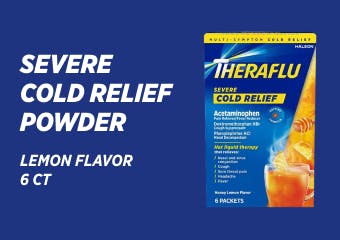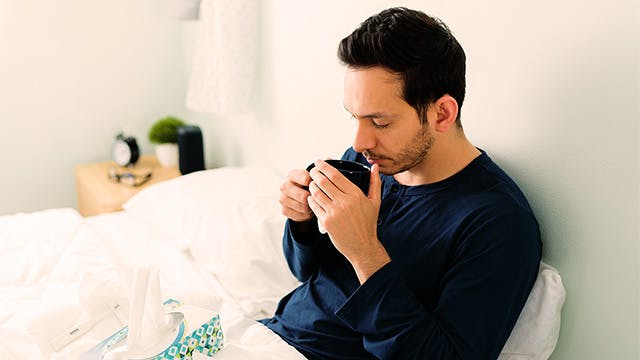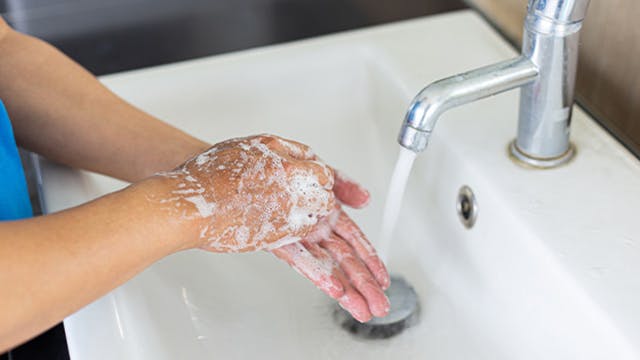How Does the Common Cold Spread?
Unfortunately, the common cold is very contagious. That’s because the viruses that cause colds can spread easily from infected people to others through the air and close personal contact. The viruses can spread through tiny droplets released into the air whenever a sick person coughs, sneezes, or blows their nose near someone else.
You can also get infected by touching a surface, like a doorknob, with virus droplets on it or by sharing contaminated objects—such as utensils, towels, toys, or phones—with someone who’s sick. So if you touch your eyes, mouth, or nose right after contact or exposure, you’re likely to catch a cold.
People who are sick are most contagious for the first 2 to 3 days of a cold.3 After about a week, most people are no longer contagious.
Should I See a Doctor for the Common Cold?
Most of the time, you won’t need to see your healthcare provider when you have a cold. Colds typically go away on their own and symptom relief can be found with over-the-counter medication and home remedies. However, if your symptoms are long-lasting or severe, you should call your healthcare provider. Keep an eye out for these signs:4
- Symptoms lasting longer than two weeks.
- Symptoms that worsen or new symptoms. This could indicate that you have another type of infection.
- A sore throat or fever higher than 100°F for longer than three days.
- Intense chest pain and shortness of breath.
How Do You Treat the Common Cold?
While there is no immediate cure for the common cold, the good news is that most people recover in about 7 to 10 days.1 To learn how to get rid of a cold and help prevent colds from coming on, check out these tips so you can protect yourself and your loved ones.
Common Cold Treatments
The common cold can result in uncomfortable or even painful symptoms such as nasal congestion, sore throat, cough, and headache. Luckily, there are plenty of over-the-counter solutions to cold symptoms that you can easily access without needing an appointment with your healthcare provider. Try out these options now to start feeling better:5
- Pain relievers. If you’re experiencing a headache or body aches while you have a cold, pain relievers like acetaminophen can ease your symptoms.
- Decongestants. Saline nasal drops and sprays are options for combatting nasal congestion. Nasal decongestants, such as pseudoephedrine, can also provide relief.
- Cold and flu medications. Over-the-counter medicines like Theraflu products can help ease your symptoms and get you back on your feet. These medications combine multiple symptom-fighting ingredients including pain relievers and decongestants. With the powerful symptom relief of Theraflu, you’ll be able to rest easier as you recover—and feel better.
Take medications only as directed. Some cold remedies contain multiple ingredients, such as a decongestant plus a pain reliever, so read the labels of cold medications you take to make sure you're not taking too much of any medication.
Home Remedies for the Common Cold
Although taking medication will provide the most symptom relief, there are other lifestyle choices and home remedies that can help your symptoms. If you have a cold, check out these tips for finding symptom relief at home:5
- Stay hydrated with plenty of fluids.
- Get a good night’s sleep and remember to rest during the day.
- Soothe your throat by gargling with salt water or sipping warm liquids.
- Try honey in hot water or tea to aid a cough.
- Add moisture to the air with a humidifier to help congestion.
What to Avoid when You Have a Cold
When you’re not feeling well, some things can make your symptoms worse. Avoid these things when you have a cold:4
- Antibiotics. For a cold, antibiotics are unnecessary as they are used to treat bacterial infections, not viruses. Taking unnecessary antibiotics can be harmful.
- Alcohol. Alcohol can worsen cold symptoms and disrupt your sleep, an important part of the recovery process.
- Smoking. Smoking can make symptoms feel worse and even prolong the length of your cold.
Cold Prevention
You won’t always be able to prevent catching a cold, but there are steps you can take to minimize your risk.3
- Wash your hands, especially before eating and after coming in contact with someone who has a cold.
- Avoiding touching your face, as cold viruses can spread from your hands to your eyes, nose, and mouth.
- Clean frequently used surfaces such as doorknobs.
Strengthen your immune system with plenty of rest, exercise, and a healthy diet.As annoying and uncomfortable the common cold can be, this sickness is luckily not serious and symptoms can usually be soothed. Taking the steps to prevent a cold and making sure to not aggravate symptoms when you are sick will ensure you stay healthy and feel your best.





